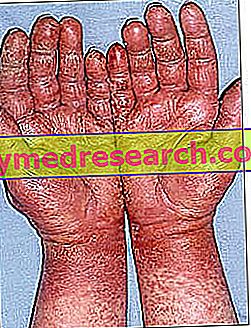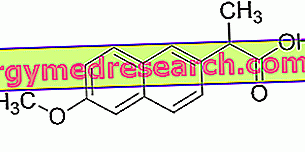Latex allergy: characteristics
Latex allergy is a set of allergic reactions triggered by the contact or inhalation of proteins contained in natural rubber latex. In the previous article we analyzed the causes responsible for latex allergies, focusing on the categories most exposed to risk. The main theme of this treatment is the symptoms associated with allergic reactions to latex.

Each individual responds in a purely subjective way to contact with latex proteins. In some cases, latex allergies run completely asymptomatically; in others, the symptoms triggered by contact with latex allergens are so severe and fierce that they seriously compromise the patient's life.
General classification
But let's go step by step: what forms of latex allergy exist ?
Latex allergies are classified according to two criteria:
- Reaction type: immediate allergic reaction, delayed allergic reaction (allergic contact dermatitis)
- Symptoms and severity of the allergic reaction: irritative contact dermatitis (which is not a true allergy), anaphylactic shock
Immediate type (or IgE mediated) latex allergy
Immediate-type latex allergies are an expression of the overproduction of specific IgE antibodies: recognizing the proteins of latex as foreign and potentially dangerous, the immune system is activated, triggering an exaggerated defensive reaction. Similar allergic forms are induced by the contact of the latex with skin / mucous membranes, or the inhalation of latex proteins.
- Contact of skin and mucous membranes with latex : in a sensitive subject, the symptoms triggered by skin contact with natural latex products (eg gloves, condoms, etc.) are comparable to those of hives:
- Redness of the skin, erythema
- Edema
- Formation of one or more wheals
- Acne-like lesions
- Mild / ferocious itching
- Skin swelling
- Edema at the level of the mouth, larynx and pharynx
- Severe generalized urticaria
- Anaphylactic reactions (severe complication)
- Violent asthmatic reactions
- Rhino-conjunctivitis
- Gastrointestinal symptoms
- Labial swellings
- Inhalation of latex proteins : latex gloves are coated internally with talc; Latex proteins, by binding to talc, are diffused into the surrounding environment by wearing and removing gloves. By putting on and taking off gloves, latex proteins can be easily inhaled, both by the person performing the action and by those around him.
The typical symptoms associated with this type of latex allergic reaction are:
- Bronchial asthma
- Breathing difficulties
- rhinoconjunctivitis
- Anaphylactic shock (in extremely sensitive subjects)
Delayed type latex allergy
Also known as "type IV reaction" and " allergic contact dermatitis ", delayed type latex allergy is a delayed skin rash, triggered by additives used during the processing of rubber (eg benzothiazole, thiocarbamate, thiourea or tiurami). Symptoms may occur 1-4 days after contact with the allergen.
This latex allergic form produces skin lesions very similar to those of eczema:
- Redness of the skin
- Bubbles on the surface of the skin
- Skin peeling
- Formation of vesicles which, breaking, form crusts
- Swelling of the face (especially in the eyes)
irritant contact dermatitis
Irritant contact dermatitis is probably the most common allergy-like reaction from contact with latex. It is a dermatitis caused by contact with latex objects. Characteristic symptoms include:
- Redness and irritation of the skin
- Non allergic eczema
- Localized itching
- Dryness of the skin
- Blisters (on areas of skin exposed to contact with latex proteins)
Non-immunological inflammatory mechanisms are implicated in contact irritant dermatitis. This form of dermatitis is improperly called "allergy", since it triggers symptoms comparable to those induced by an allergic reaction to latex (in this specific case). In fact, contact dermatitis manifests itself in response to contact with latex which, in sensitive subjects, attacks the skin through a direct mechanism, precisely at the point of contact with the "allergenic" substance.
Anaphylactic shock from latex allergy
Anaphylactic shock - or anaphylaxis - is the most feared and terrible complication induced by all allergies, including allergic reactions to latex.
In particularly sensitive people, anaphylactic reactions may appear even a few minutes after the exposure (contact or inhalation) of the latex proteins. The most common signs and symptoms are:
- breathlessness
- anguish
- Bradycardia / tachycardia
- Dyspnea (difficulty breathing) due to constriction of the respiratory tract
- Abdominal pain
- Drastic reduction in blood pressure
- Swollen tongue
- Urticaria
- Loss of consciousness
- fainting
- Dizziness
- He retched
However, it should be pointed out that only rarely does anaphylactic shock manifest itself immediately after the first exposure to natural rubber: the allergy symptoms to latex proteins tend to occur gradually, at least in most cases diagnosed. Once sensitivity to latex is developed, allergy symptoms appear faster and faster, with variable skin and respiratory manifestations.
Anaphylactic shock constitutes a clinical emergency in all respects, and requires immediate relief: violent latex allergies can cause the death of the subject.



